I love all things Italian, and my first antipasto salad experience was unforgettable. Walking into a cozy trattoria in Rome, I was hit with the smell of meats, olives, and herbs. It was like a call to explore this classic dish.
In this guide, we’ll explore the world of antipasto salad. We’ll look at its origins, different versions, and key ingredients. Whether you’re into Italian food or just want to try something new, you’ll learn how to make a delicious antipasto salad.
Table of Contents
Understanding the Tradition of Italian Antipasto
Antipasto, or “before the meal,” is a key part of Italian food history. It has grown over centuries, showing the variety of Italian cuisine. This tradition is loved by many.
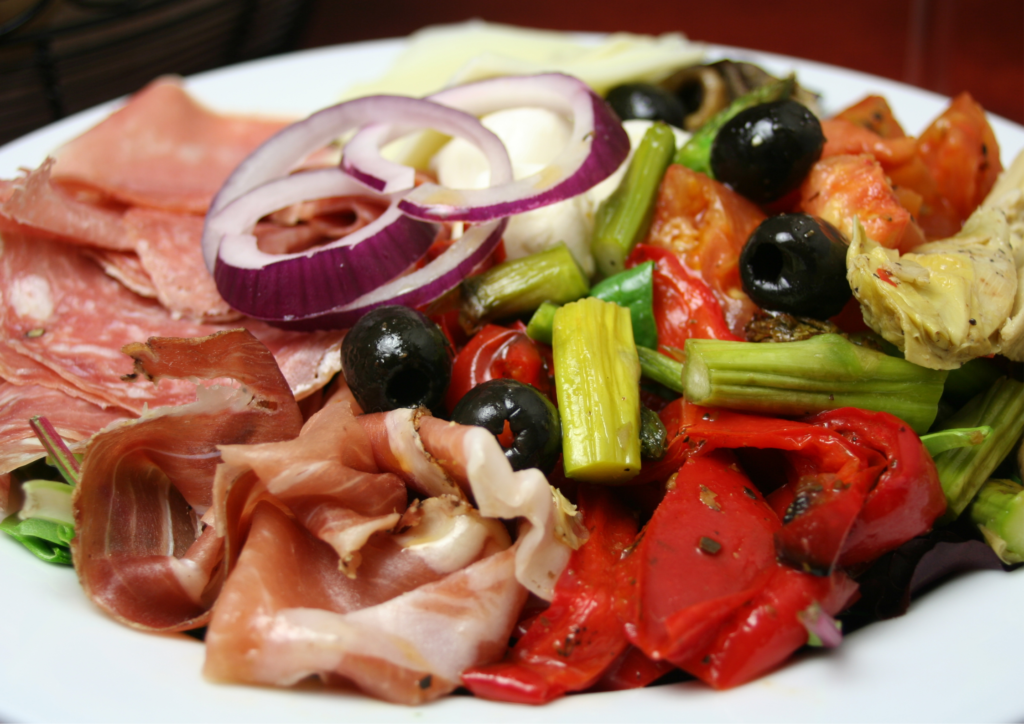
Origins in Italian Dining Culture
Antipasto started in ancient Rome with small plates of cured meats, olives, and cheese. These were served to get people ready for the main meal. Over time, it became a special part of Italian meals, preparing the palate for what’s to come.
Regional Variations Throughout Italy
In Italy, antipasto varies by region. Coastal areas offer seafood, while the north focuses on cured meats and cheeses. This variety highlights the richness of Italian food history and regional Italian cuisine.
The Social Aspect of Antipasto
Antipasto is more than just food; it’s a social event. In Italy, sharing an antipasto traditions platter is a time for friends and family to come together. It’s a moment for laughter, conversation, and enjoying good food and company.
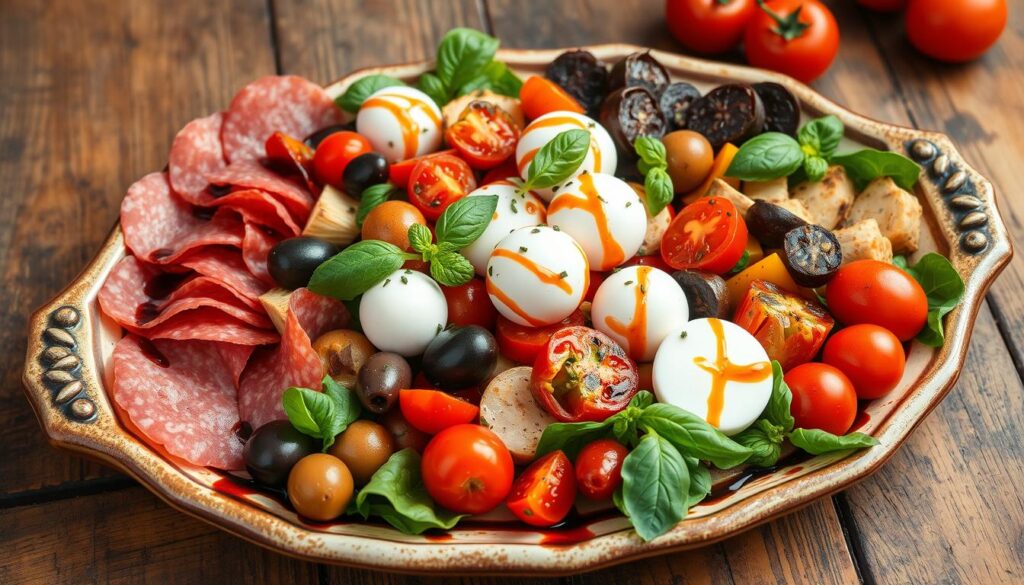
Essential Ingredients for Antipasto Salad
Making a great antipasto salad is about picking the right mix of classic Italian ingredients. You need cured meats, tangy cheeses, and fresh veggies. Each part is key to getting that Mediterranean taste. Let’s look at the must-haves for this tasty appetizer.
The salad starts with fresh, seasonal veggies. You’ll use crisp romaine lettuce, juicy tomatoes, and crunchy cucumbers. Add peppery arugula or spinach for more flavor. Roasted red peppers, marinated artichoke hearts, and briny olives bring their own tastes and textures.
- Romaine lettuce
- Tomatoes
- Cucumbers
- Arugula or spinach
- Roasted red peppers
- Marinated artichoke hearts
- Olives
Cured meats like prosciutto, salami, or pepperoni are a must. They add a savory touch to the salad. Don’t forget the cheeses, from firm Parmesan to creamy bocconcini or tangy feta.
| Cured Meats | Cheeses |
|---|---|
| Prosciutto | Parmesan |
| Salami | Bocconcini |
| Pepperoni | Feta |
Finish the salad with garnishes like fresh herbs, toasted pine nuts, or crunchy croutons. They make the salad look good and add more taste and texture.
By choosing and mixing these antipasto components carefully, you can make a lively and tasty Italian salad. It will celebrate the rich Mediterranean flavors of Italy.
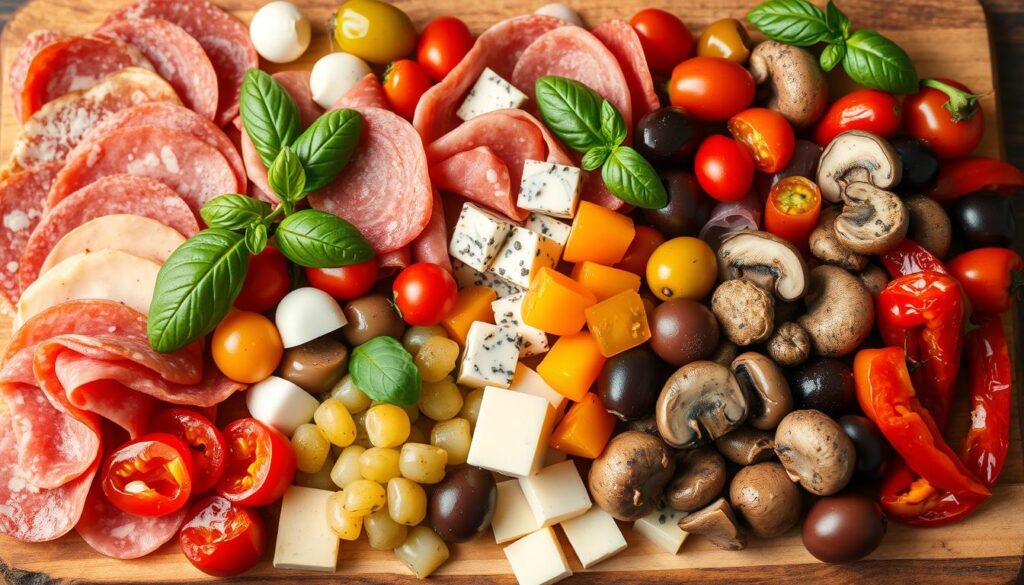
Selecting and Preparing Fresh Vegetables
Making the perfect antipasto salad starts with picking and preparing fresh, vibrant produce. The right mix of vegetables can make this classic Italian appetizer even better.
Best Vegetables for Texture and Flavor
For a great antipasto salad, you need a mix of textures and flavors. Here are some top picks:
- Crisp romaine lettuce or arugula for a fresh base
- Juicy tomatoes, like cherry or grape, for sweetness
- Crunchy radishes, cucumber, or celery for a satisfying bite
- Bright bell peppers, sweet and spicy, for depth
- Marinated artichoke hearts or olives for briny flavor
Proper Cutting and Presentation Techniques
When cutting veggies, think about flavor and looks. Slice, dice, or chop them into small, uniform pieces. This makes the salad look good and easy to eat.
Seasonal Vegetable Options
Using seasonal veggies makes your salad fresh and flavorful. In spring, add asparagus and peas for crunch and sweetness. Summer brings zucchini, eggplant, and corn for a summery taste. As it cools, carrots, beets, and potatoes add heartiness.
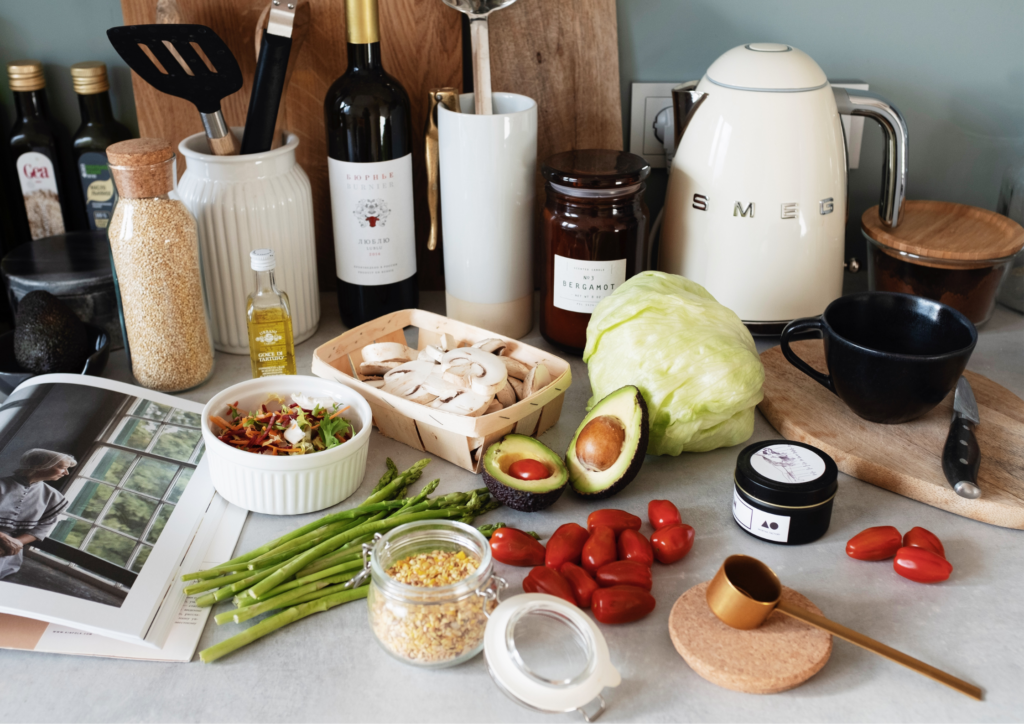
By choosing and preparing a variety of fresh, seasonal veggies, you’ll make an antipasto salad that’s stunning and full of flavor.
Choosing the Right Cured Meats
Making a true Italian-inspired antipasto salad means picking the right cured meats. These salumi add flavor and texture. From prosciutto to salami, each meat brings something special to your salad.
Here are some tips for picking salumi:
- Choose high-quality, artisanal Italian cured meats without preservatives. Look for labels that say where they’re from, like Prosciutto di Parma.
- Get a mix of charcuterie for looks and taste. Try prosciutto, salami, mortadella, and capocollo.
- Think about the texture and taste of the meats. Prosciutto is delicate, while salami and mortadella are bold.
- Don’t overdo it with the salumi. Thin slices or small pieces are best to balance the salad.
By picking the right Italian cured meats, you’ll make your antipasto salad amazing. It will take your guests on a tasty trip through Italy.
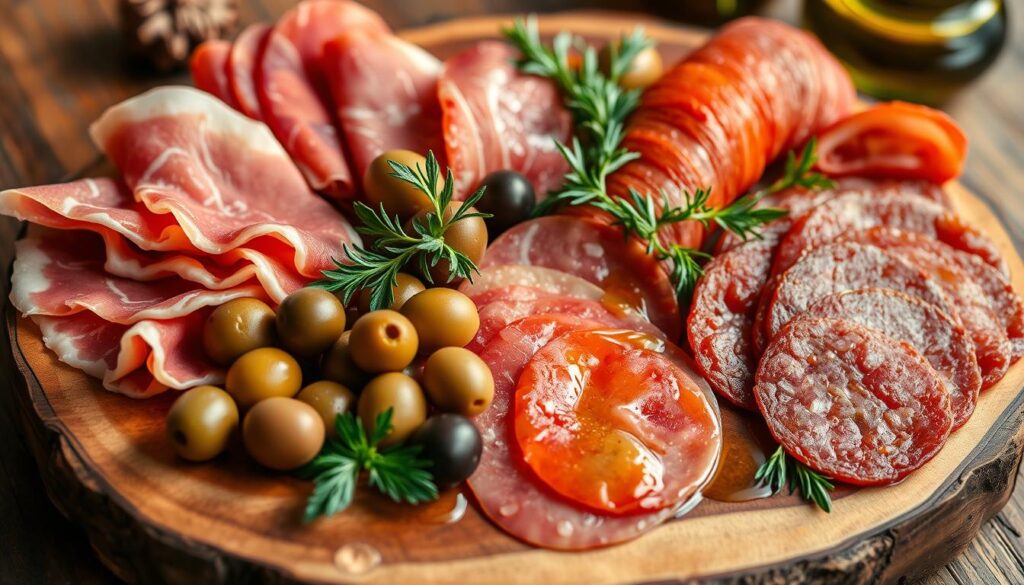
Perfecting Your Cheese Selection
Choosing the right cheese is key to a great antipasto salad. Italian cheeses bring a world of flavors and textures. They can make this classic dish even better. Let’s look at hard and soft Italian cheeses and how to store them.
Hard Cheese Options
Parmesan, Pecorino, and Asiago are top picks for hard Italian cheeses. They add depth and complexity to your salad. These cheeses have strong, nutty, and salty tastes that go well with other ingredients. Choose high-quality, authentic Italian cheeses for the best taste and texture.
Soft Cheese Varieties
Soft cheeses like mozzarella, burrata, or ricotta are creamy and indulgent. They offer a nice contrast to the cured meats and crunchy veggies in your salad. These cheeses make your salad more interesting.
Proper Cheese Storage Tips
- Keep artisanal cheese in the fridge, wrapped in wax paper or parchment to let it breathe.
- Hard cheeses do well in a cheese cave or a container that controls humidity to stay fresh.
- Softer cheeses should be eaten within a few days for the best taste and texture.
By picking the right Italian cheeses and storing them correctly, you can make your antipasto salad unforgettable.
The Art of Marinated Components
Marinated vegetables, olives, and pickled ingredients are key to a great antipasto salad. They add flavor and texture. They also bring a nice balance of acidity, saltiness, and sweetness.
There are many choices for marinated vegetables. Artichoke hearts, roasted bell peppers, and pickled onions are great. Try different vinegars, herbs, and spices to find the perfect mix.
If you buy marinated items, choose high-quality ones without preservatives. Look for brands that use fresh ingredients. Avoid anything too acidic or salty.
Homemade Marinade Tips
- Start with red wine vinegar, balsamic vinegar, and olive oil.
- Add fresh herbs like rosemary, thyme, and oregano.
- Use a little honey or maple syrup for sweetness.
- Garlic, shallots, and crushed red pepper flakes add flavor.
- Marinate for at least 30 minutes, or up to 24 hours, for best taste.
Selecting Store-Bought Marinated Components
- Choose brands with high-quality, fresh ingredients.
- Stay away from products with many preservatives or additives.
- Look for a good balance of acidity, saltiness, and sweetness.
- Choose a mix of textures and flavors, like marinated vegetables, olives, and pickled ingredients.
| Marinated Ingredient | Flavor Profile | Suggested Uses |
|---|---|---|
| Roasted red peppers | Sweet, smoky, and slightly acidic | Add to the salad, use as a garnish, or serve on the side |
| Marinated artichoke hearts | Tangy, slightly earthy, and a touch of brininess | Toss into the salad or serve as a standalone component |
| Kalamata olives | Bold, salty, and slightly fruity | Scatter throughout the salad or use as a garnish |
| Pickled onions | Tangy, sweet, and crunchy | Add to the salad for a pop of color and flavor |
Using a variety of marinated and pickled ingredients makes your antipasto salad stand out. It ensures a balanced and delicious dish.
Creating the Perfect Antipasto Salad Dressing
At the heart of any great antipasto salad is the dressing. Making an authentic Italian salad dressing is an art. It’s all about finding the right mix of olive oil and vinegar.
Traditional Italian Dressing Base
The base of a traditional Italian dressing is extra virgin olive oil. This Mediterranean staple adds a rich flavor. Mix it with red wine vinegar or balsamic vinegar for a tangy taste.
Herb and Seasoning Combinations
- Fresh herbs like basil, oregano, and parsley add vibrant notes to the dressing.
- Minced garlic and crushed red pepper flakes can provide a subtle kick of heat.
- Dried spices like Italian seasoning, fennel seeds, or ground black pepper contribute depth and complexity.
Vinegar and Oil Ratios
Finding the right vinegar and oil mix is key for a great olive oil dressing. Start with 1 part vinegar to 3 parts oil. Then, adjust to your liking. Try different vinegars to match your salad’s flavor.
With a bit of trial and error, you can make a homemade Italian salad dressing. It will take your antipasto salad to new heights of taste and authenticity.
Assembly and Presentation Tips
Making a tasty and beautiful antipasto salad is like art. It’s all about how you present it. From choosing the right food to how you arrange it, every detail matters. Let’s dive into the secrets of putting together and showing off your Italian-style salad.
Mastering the Plating Technique
The way you display your antipasto salad is key. Pick the right dish, whether it’s a big platter or small plates. Arrange the ingredients in a way that looks good, balancing colors and textures.
Layer the veggies, meats, and cheeses neatly. This lets each part stand out.
Elevating with Garnishes
Garnishes can elevate your salad. Use fresh herbs, flowers, or olive oil to add class. Try different garnishes to highlight the salad’s taste and look.
Serving Suggestions
- For individual servings, arrange in circles or spirals for a nice display.
- For groups, use a big platter or board. Arrange ingredients so guests can easily grab what they want.
- Remember to have utensils like small forks or toothpicks for guests to use.
| Plating Technique | Suggested Garnishes | Serving Suggestions |
|---|---|---|
| Layered arrangement | Fresh basil, oregano, or rosemary | Individual plates or central platter |
| Circular or spiral pattern | Edible flowers (e.g., nasturtiums, marigolds) | Small forks or toothpicks for easy serving |
| Geometric design | Drizzle of high-quality olive oil | Encourage guests to assemble their own plates |
Mastering presentation and plating can turn your antipasto salad into a stunning centerpiece. Try out different ways to arrange your salad. Find the perfect way to show off its flavors and textures.
Make-Ahead and Storage Guidelines
Preparing your antipasto salad parts ahead of time saves you time. It also keeps your ingredients fresh. By storing them right, you keep the salad’s flavors and textures great.
Proper Storage Methods
Storing your antipasto salad ingredients right is key. Here’s how to keep them fresh:
- Vegetables: Store chopped or sliced veggies in airtight containers in the fridge. This keeps them crisp and fresh.
- Cured Meats: Wrap cured meats like salami and prosciutto tightly. Use their original packaging or resealable bags. This keeps their taste and prevents drying.
- Cheese: Wrap hard cheeses in parchment or wax paper and refrigerate. Soft cheeses go in their original packaging or airtight containers.
- Marinated Components: Store marinated olives, artichokes, or peppers in their marinade in the fridge. This keeps their taste and texture.
Maintaining Freshness
Assemble your antipasto salad just before serving for the best taste. This lets the flavors mix and the textures stay crisp. Keep the ingredients chilled until you’re ready to serve for the best food storage, meal prep, and fresh ingredients preservation.
Wine Pairing Suggestions
Making the perfect antipasto salad is an art. Pairing it with the right Italian wines can make it even better. The flavors and textures of your salad are key to finding the perfect wine.
For a classic salad with cured meats, veggies, and cheeses, try light to medium-bodied Italian reds. Chianti is great because it’s acidic and has soft tannins. It cuts through the salad’s richness. Barbera or Montepulciano offer a bold, fruity taste that contrasts well.
White wine lovers might enjoy a crisp Pinot Grigio or a refreshing Verdicchio. These wines are light and citrusy. They balance the salty, savory flavors of the salad.
For a more aperitivo feel, try a sparkling Prosecco or a dry Moscato. Their bubbles and slight sweetness contrast nicely with the salad’s salty, umami flavors.
| Wine Pairing | Wine Varietal | Flavor Profile |
|---|---|---|
| Red Wine | Chianti, Barbera, Montepulciano | Light to medium-bodied, with vibrant acidity and subtle tannins |
| White Wine | Pinot Grigio, Verdicchio | Crisp, citrusy, and refreshing |
| Sparkling Wine | Prosecco, Moscato | Effervescent, with a touch of sweetness |
Try different Italian wines to find the best match for your antipasto salad. Whether you like bold reds, crisp whites, or bubbly wines, there’s something for everyone. Each varietal can bring out the best in this classic Italian dish.
Conclusion
Creating a classic Italian antipasto salad is a fun way to improve your appetizers. You’ve learned about its rich history, picked the best ingredients, and learned how to put it together. Now, you can enjoy the amazing flavors and textures that make it so special.
This salad is perfect for any event, whether it’s a casual get-together or a fancy dinner. It’s easy to make and fits well with the Mediterranean diet. It’s a hit with everyone, making it great for health-conscious and food-loving guests.
Keep trying new things with your antipasto salad. Always remember the true spirit of this Italian favorite. Show off your creativity and add your own touch, while keeping the traditions alive.
FAQ
What is the traditional role of antipasto salad in Italian cuisine?
Antipasto salad is a classic Italian appetizer. It comes before the main meal. It has cured meats, cheeses, marinated vegetables, and more. These ingredients get you ready for the meal ahead.
How do the ingredients in an antipasto salad contribute to its overall flavor profile?
The mix of salty meats, tangy cheeses, briny olives, and marinated veggies creates a perfect flavor balance. The different textures, like crisp veggies and creamy cheese, make it a feast for the senses.
What are some of the most popular cured meats used in antipasto salad?
You’ll often find prosciutto, salami, pepperoni, mortadella, and capicola in antipasto salads. These meats add a rich, savory taste.
How can you incorporate seasonal produce into your antipasto salad?
Adding fresh veggies and fruits like tomatoes, artichokes, and olives boosts the salad’s taste and looks. Picking ingredients at their peak ensures the best flavor and nutrition.
What are some tips for properly storing and assembling an antipasto salad?
Store each ingredient separately to keep it fresh. Drain and pat dry marinated veggies to avoid a soggy salad. Arrange the ingredients nicely on a platter for a stunning presentation.
How can you pair an antipasto salad with the right wine?
Think about the saltiness of the meats and the acidity of the dressing. Light white wines like Pinot Grigio or Sauvignon Blanc pair well. Bolder reds like Chianti or Montepulciano d’Abruzzo also work great.

